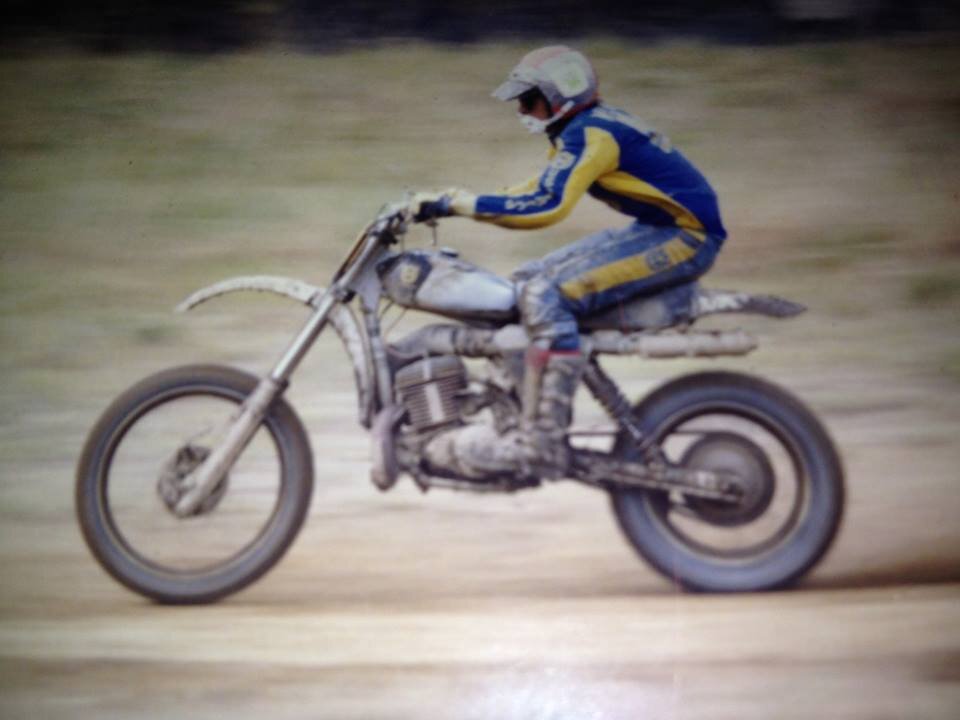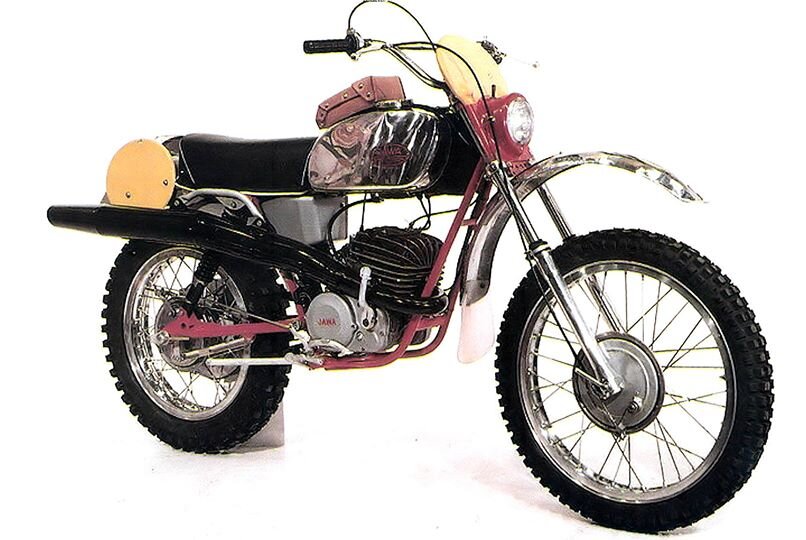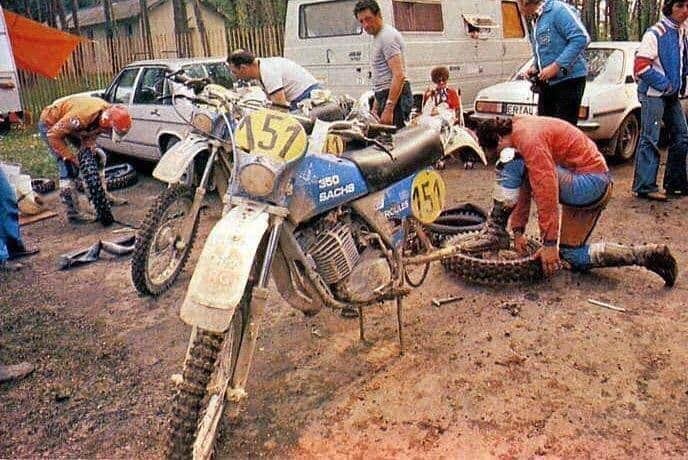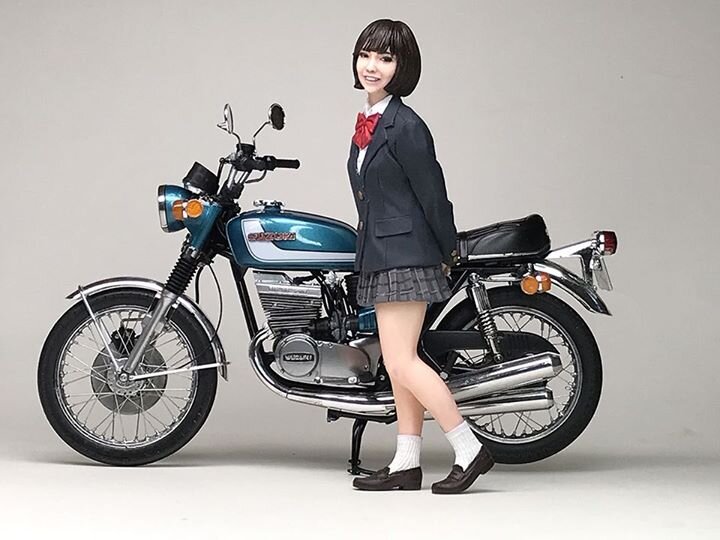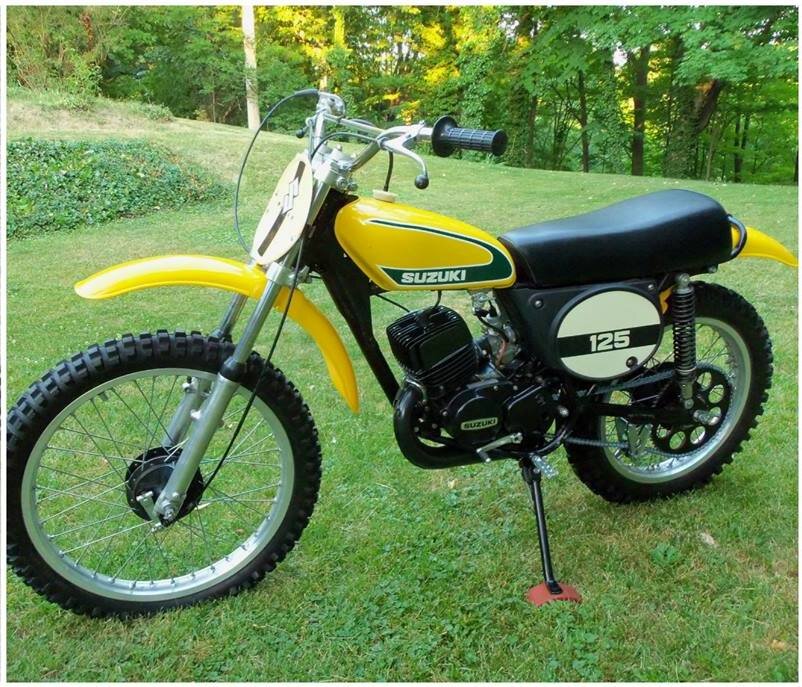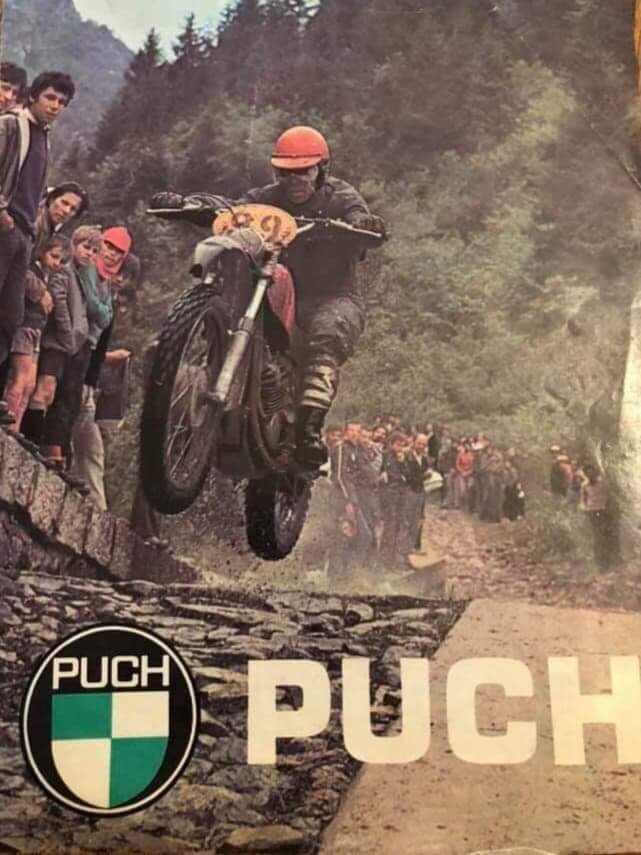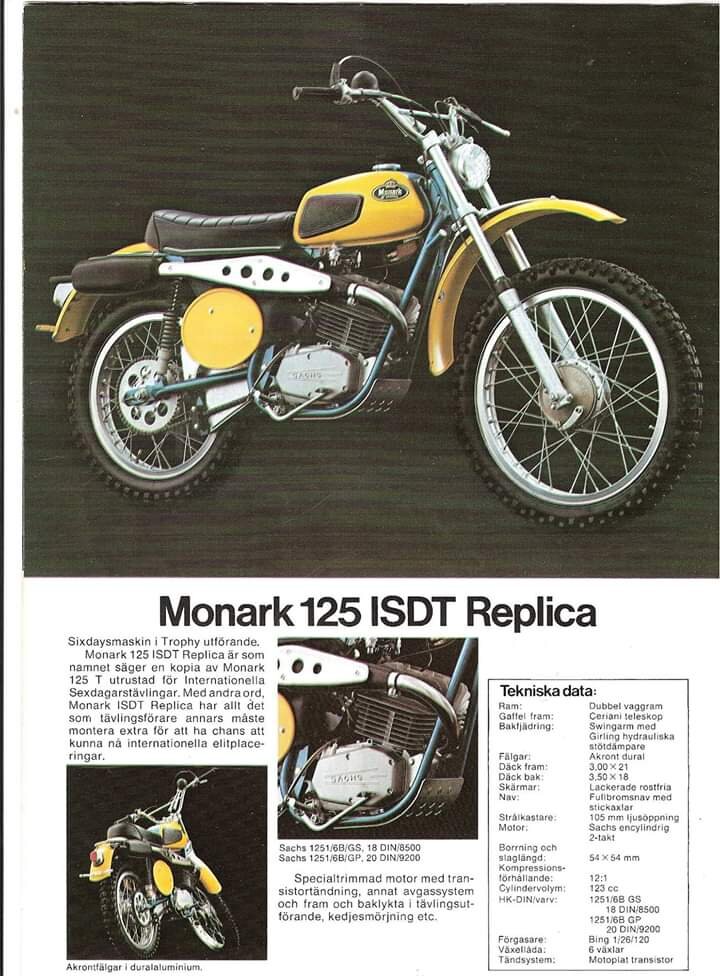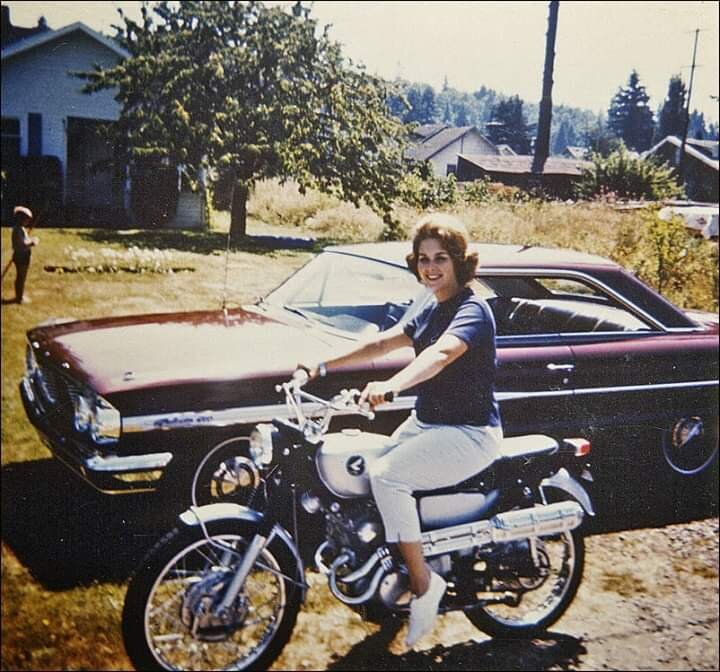Photos
Motorcycling is all about imagery. Here are just some random, fun photos.
First up, a few pictures from “back in the day”. Here’s a shot of Bob on his ‘79 390 Husky. At the time, Bob was one of the top riders in the highly competitive Competition Riders of America racing series, with events held all over Northeastern Ohio. Some of the best off-road riders in the United States have come out of this area. Such is the level of competition, and the severity of the terrain over which the races are held, it is said that if you can win a CRA event overall, you can win nationally. Bob’s commitment to job and family prevented him from heading out cross-country to race nationally, although he was hoping to run the ISDT/E qualifiers and earn an opportunity to compete in the International Six-Day Trials - when an injury prematurely ended his racing career. At the time, he was the man to beat, consistently winning CRA Hare Scrambles events overall, including an amazing string at one time of twelve in a row.
Ted Guthrie - the “other half” of The Vintage Movement. Another back in the day shot, this one aboard a 1980 Yamaha YZ250G, taken during a Hare Scramble at the infamous, old Big Valley track, in East Palestine, Ohio. Unlike Bob Wentzel, who was one of the top racers of that era, Ted was just an average competitor, fortunate to once-in-a-while score a trophy. Still, it was a fun and memorable time.
If you’re a fan of the International Six-Days Trial, you will immediately recognize the name Jawa. Founded in 1929 in Prague, Czechoslovakia, this manufacturer of basic, transportation motorcycles nonetheless went on to eventually produce some of the most effective and prolific machines for ISDT competition. Basic and heavy, yet quite effective and extremely durable and reliable, these bikes, and the Czech team, were a dominant force over several decades, winning numerous International and Silver Vase titles.
I’ve not researched this particular Jawa model, but in general it appears to be from the late 70’s, as suggested by the slightly forward-mounted rear shocks. A beautifully restored example, this image was provided to us by Wes Habermehl.
Ah, the infamous ISDT/E five-minute tire changes. For those of you unfamiliar with this aspect of motorcycling, ISDT/E stands for International Six Days Trial (now Enduro). Often referred to as the Olympics of motorcycling, the events are six consecutive days of off-road competition, in which teams of riders representing their home countries compete for bronze, silver, and gold medals.
In order to assure the best performance possible from their machines throughout the week-long competition, riders repeatedly install fresh tires. However, ISDT/E rules require not only that the rider alone must performance all maintenance on his or her machine, but also that they do so within just a brief work period at the beginning or end of each day’s competition. As a result, riders must be capable of changing tires in just a few minutes.
How do they do it? Practice, for one thing. Plus, a few rearrangements to the motorcycle. Notice for example that this Italian rider’s Sachs is equipped with a center stand. Also, ISDT-prepped motorcycles feature condensed components to simplify wheel removal/re-installation. Plus, rim locks are typically dispensed with, relying instead on dimples or roughened edges on the inside of the rim to prevent the tire from rotating. Other tricks include shaving down one side of the rim for less overlap. Whatever these means employed, the bottom line is that each and every ISDT/E rider is exceptionally skilled - not only in their riding capabilities, but in bike prep and maintenance, as well.
Suzuki’s GT series of 2-stroke street bikes were a somewhat underrated, but nonetheless excellent group of motorcycles. Produced through the late 70’s, this line of two and three-cylinder machines did not particularly enjoy the performance reputation of their Yamaha and Kawasaki counterparts, as Suzuki elected to design their “smokers” more for smooth power and long-lasting reliability. Taken from what appears to be a home-market promotional shot, this image could be either a 380 or 550 model, although the chassis size suggests the 380 version. Interestingly, graphics appear to be from a ‘72 model, but Suzuki did not introduce a disc brake up front until ‘73. Note the skinny tires typical of the era. Plus, a couple of features unique to Suzuki’s products - one, the Ram Air System scoop on top of the cylinder head(s), intended to force cool air over the engine. Also, but not evident in this side-image is the three-into-four exhaust system. Yep, for a balanced, cosmetic appearance, Suzuki went to the trouble and expense to equip these three cylinder bikes with junction-connectors in the exhaust system, providing for four, functional mufflers. Lastly, and quite endearingly - Suzuki back then assigned model names to each of their bikes. In this case, the 380 was called the “Sebring”, and the 550, the “Indy”. Great bikes, all.
Yes, that is actor Paul Newman, tooling around on a Honda Superhawk. Photo was reportedly taken at the Indianapolis speedway, in 1969, and that is Paul’s daughter, Melissa, along for the ride. The year could very well be correct, as the bike appears to be Honda’s ‘Hawk from that year. Pretty cool image, regardless. Hey, have Bob tell you the story someday about when he met Newman in person - under less-than-typical circumstances.
So, what do we have here? It’s an Italian Moto Villa. I have no specifics of exact year and model, but general layout suggest ‘74-ish(?). These were made in 250 and 450 versions, and while there’s some big finning on that jug, the smaller-diameter pipe suggests a 250. Some interesting features. Shiny paint on the tank indicates it is metal. Boxed swingarm looks pretty sturdy. And, even though this bike was likely produced well into the 70’s - no silencer! Check out the piece of lumber holding the bike up in this image. Basic, but effective. The Moto Villa company was founded by Francesco Villa, who previously worked with Ducati, Mondial, and Montesa. First bike produced by Francesco’s new company was released in 1968. A full line of products were eventually produced, including some very effective roadracers, and Moto Villa’s Motocross bikes enjoyed considerable success in European competition. This is a rare one, and pretty snazzy, too. Obscure photo was dug up, as always, but TVM’s archivist - Wes Habermehl. Thanks, Wes!
By the early 1970’s, dirt bikes were really becoming refined. Light weight, substantial power, quality components, and reasonably-good handling. Besides, they were oh-so pretty. The early 125 Motocrossers for example, such as this ‘74 TM125, were and are extremely popular. So tiny by today’s standards, they are impossibly narrow, low to the ground, and an absolute blast to ride.
Check out this 1966 ad for Yamaha’s Big Bear Scrambler. Named for the classic Big Bear Hare and Hound off-road race in California, this 250cc twin certainly was not ready to take on the California desert right out of the crate. Regardless, by the mid-60’s, the Japanese were offering a bunch of quality, high-performance machines, and the Big Bear is a good example. Oil-injected, twin-cylinder, five-speed gearbox, a tubular frame, reasonably-good handling, and double-leading-shoe brakes, not to mention solid reliability. About that reasonably good handling - note the factory steering damper. Speaking from experience, those bikes needed it. I once unscrewed the damper on one of these old bikes, just to see what difference it made. Yikes! Felt like both tires were flat. Good feature. Thanks, Yamaha. Gotta love the ad content. “Dust-proof and waterproof brakes.” Not sure exactly what that means, but ok. “Finest colors in the motorcycle industry.” How was that determined? And then there are the “hairy high pipes”. Yeah! Well, remember that this was the era of Street Scramblers, and you’ve got to admit - those pipes look pretty cool. As far as the imagery, typical 60’s - no helmets, jackets, boots, gloves, or pesky eye-protection. Nope, just clean-cut, wholesome, young people, out having a great time on their Yamaha Big Bear Scrambler. Those were the days.
Although The Vintage Movement is all about any and all vintage motorcycles, Bob and Ted’s personal interests are closely tied to dirt bikes from the 1970’s, hence much attention paid to such machines - particularly off-road bikes, designed for off-road riding, Enduro competition, Hare Scrambles, and the International Six-Day Trial. Much has been written over the years with respect to Motocross bikes and Motocross riders, and TVM is certainly a big fan of all things MX,. However, our intention is to bring to light some of the great bikes, great riders, and great events, which over the years have made up the off-road world. Thanks to our friend Wes Habermehl, TVM’s unofficial archivist, for this awesome, classic shot of a Puch, quite obviously taken at a European event, back in the 1970’s. Much more to come on this type of bike on the TVM website, such as a history of Puch motorcycles.
Here’s a rare one. Never-released CZ Observed Trials bike. Back in the early 1970’s, it was generally believed throughout the industry that Trials was going to be the “next big thing”. Requiring relatively little land, featuring low-impact on the environment, and representing very little in the way of noise issues, Observed Trials conceivably could have been the answer to many off-road issues. Combine that with very entry-level-friendly-type competition, low-maintenance requirements of the motorcycles utilized, and small, lightweight bikes utilized, there were suggestions that Trials could become as big as Motocross. As a result, virtually every manufacturer either introduced a Trials model, or at least worked at development of one. Apparently, CZ experimented a bit, and here is the result. Some quite-interesting features, here. Shouldered rims, alloy tank and fenders, and quite well-tucked-in exhaust system suggests this one had potential. However, Observed Trials never did generate the high level of interest which was hoped for, and after a couple of years only a few manufacturers continued producing specialized Trails machinery. That leaves this CZ as one of those what-if bikes, that never was. Our thanks to Wes Habermehl for locating this super-rare image.
Yet another super-obscure photo, provided by our intrepid finder-of-rare-and-special images, Wes Habermmehl. Featured here is a super-cool, early 70’s ad for Monark’s 125 Enduro, designated as an “ISDT Replica” - with text in Swedish, no less! Dating to the early part of the 20th century, Monark motorcycles rose to prominence in the 1950’s, when they entered a team in the International Six-Day Trials. Additionally, a factory Monark piloted by Sten Lundin won the 1959 500cc Motocross World Championship. Interest in the U.S. peaked in the early 70’s, when the obscure brand was ridden to considerable success in Motocross competition by rising stars such as Marty Smith. That all changed however, with the introduction of Honda’s 125 Elsinore. As with other smaller manufacturers, Monark simply could not keep pace with the fast-evolving motorcycle world of that era, and the Swedish firm ceased motorcycle production in 1976. This particular version features a Sachs engine, along with ISDT-ready components - note the license plate bracket, and bulb horn!
Wow, check out mom on an awesome, brand-new Honda CL Scrambler. Terrific little bike. Maybe a 160? Check out the double-leading-shoe front drum brake. Now, is this one hers, or is she just posing on the old man’s bike? Don’t know, but she’s got her index finger out there on the clutch lever, so maybe she knows what she’s doing. Regardless, great details to pick out in this terrific old image, not the least of which is the ‘64 Ford Galaxie two-door hardtop. Yowza! Skinny, bias-ply whitewalls, and dig those dog dish hubcaps! Plus, check out mum’s groovy hairstyle, and they ever popular white capris and sneakers. Also, house and yard of typical of early-mid-60’s suburbia. Gravel drive, no fancy landscaping, and plenty of natural growth in the empty lot next door which, since these lots were first cleared for new houses, has not yet grown up into woods. And that’s the way it was.
There’s no doubt that by the mid-60’s, the Japanese manufacturers were greatly impacting the motorcycling industry. The reasons were obvious - solid engineering, a quality product, excellent performance, total reliability, and at affordable prices. This early Kawasaki (pre-F11) is an excellent example of what drew many buyers to extremely popular Japanese “Enduros”, back in the day. Ok, so maybe it was heavy, had modest power, and didn’t handle all that great, but look at it! Is that a nice-looking bike, or what? Beautiful paint, chrome, full instrumentation, the convenience of oil-injection, and best of all - full street legal. Yes indeed, these were bikes you could truly ride to the trails, enjoy a day of fun, ride home, then ride the same bike back and forth to school or work all week long. And all things considered, they worked pretty darn good, especially with a set of knobbies mounted up. Plus, many, many of them got stripped down and pressed into more serious off-road riding and competition. Yep, these indeed were bikes which changed the motorcycling world forever.

